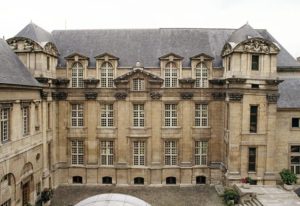Each month, a researcher shares their experiences of using a particular archive. The overall aim of this section is to create a database of the different archives available to those working on French and Francophone studies that will be of help particularly to students just starting out in research.
Kaylee P. Alexander is a PhD candidate in the Department of Art, Art History & Visual Studies at Duke University. Her dissertation research focuses on the visual culture of the cemetery and the market for funerary monuments in nineteenth-century Paris. Here she talks about the resources available for historians of France at the Bibliothèque historique de la Ville de Paris.

Housed within the sixteenth-century Hôtel Lamoignon in the heart of the Marais neighboorhood, the Bibliothèque historique de la Ville de Paris (BHVP) holds an immense collection of printed books, manuscripts, plans, drawings and ephemera related to the history of Paris and the Île-de-France region, as well as to French theatre and literature (notably the Association de la Régie Théâtrale and George Sand).
Founded by Jules Cousin following the burning of the Bibliothèque de la Ville de Paris during the Commune de Paris in 1871, the BHVP moved from its original location at the hôtel Carnavalet (now the Musée Carnavalet – Histoire de Paris) to its present one in 1969. Coinciding with the fifty-year anniversary of its move to the hôtel Lamoignon, the library’s reading room is currently undergoing renovations, which are expected to be complete by October 31, 2019.*

Due to the library’s unique collection of ephemeral materials, my visit was motivated by my doctoral research on the market for funerary monuments in nineteenth-century Paris. As these objects have rarely survived into the present, I was hoping to find really anything related to the marble and stonework industry. While my work in the BHVP’s collections is just getting started—the catalogue system takes some getting used to—I’ve already encountered some unique finds, such as an album of monument designs dating to 1885.
Without a doubt, the best aspect of the BHVP is that you never really know what you’re going to come across. The size and variety of its collection makes it a bit intimidating and difficult to navigate, but it is a must for anyone working on Parisian history. Luckily, the staff is incredibly knowledgeable and willing to assist researchers. During my first visit, a staff member even walked me through the request system and called my first items for me. This was great for the handful of items I already knew I wanted to see, though navigating the digital catalog (which is combined with all of the Bibliothèques specialisées) is another story. You’re likely better off using the printed volumes in the reading room; you’ll be much more likely to find what you didn’t know you needed.

1. Getting there is an easy 5-minute walk from the Saint-Paul métro station (line 1) and bus stop (lines 69, 76 and 96). The 29 bus lets off even closer, at the Payenne stop, just around the corner from the library’s entrance.
2. Bring a passport photo (3.5 cm x 4.5 cm) with you if it is your first time visiting; you will need this to inscribe and get your reader card. There is a passport photo machine conveniently located in the Saint-Paul métro station, so you can always grab a photo en route to the library. NB: Your reader card is valid at all of the bibliothèques specialisées de la ville de Paris.
3. Photographing documents is permitted for personal/scholarly use. Be sure, however, to notify the staff in the reading room as you will need to fill out slips for each document that you photograph. They can also facilitate requests for professional reproductions.
4. WiFi is available for free throughout the library. The connection is fairly strong compared to what I’ve experienced in other Parisian libraries and was also available in the courtyard (this proved useful during my lunch breaks).
5. Beverage vending is available in the library near the lockers if you need a quick break, but you’ll have to bring lunch or explore the Marais for sustenance if you plan to spend the day. There are many lunch options (dine-in and take-away) within walking distance of the library. If you’re willing to battle the tourist crowds along the rue des Rosiers, l’As du Fallafel is my personal favorite for cheap eats; they have some of the best shawarma and falafel in Paris. Lines can be long but move pretty quickly for take-away (which you can enjoy back at the courtyard of the BHVP).
* Access to the library’s unique holdings during the renovation period is available by appointment.
Kaylee P. Alexander is a Ph.D. Candidate in the Department of Art, Art History & Visual Studies at Duke University, where she is also a research assistant with the Duke Art, Law & Markets Initiative (DALMI). Her dissertation research focuses on the visual culture of the cemetery and the market for funerary monuments in nineteenth-century Paris. Her website can be found at www.kayleealexander.com and her twitter handle is @kpalex91
Thank you very much for this, Kaylee!


